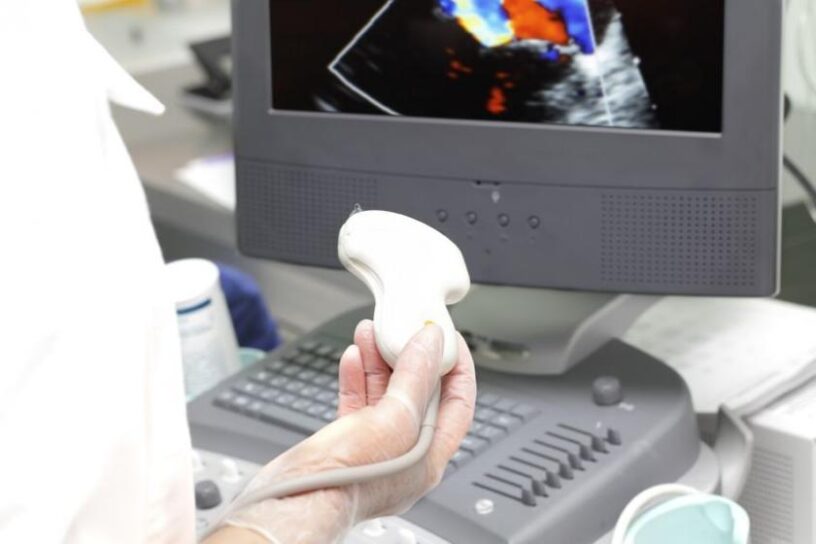Intravascular Ultrasound (IVUS) Devices Market size was valued at USD 771.9 million in 2022 and is expected to expand at a compound annual growth rate (CAGR) of 5.1% from 2023 to 2030.
The Intravascular Ultrasound (IVUS) devices market involves the development, manufacturing, and distribution of medical imaging systems and catheter-based devices used for intravascular imaging and assessment of coronary arteries and peripheral vessels. IVUS technology employs high-frequency ultrasound waves to visualize the inner layers of blood vessels, providing detailed cross-sectional images of the vessel lumen, plaque morphology, and vessel wall characteristics. IVUS devices play a crucial role in interventional cardiology, vascular surgery, and peripheral vascular interventions by aiding in the diagnosis, treatment planning, and optimization of procedural outcomes in patients with cardiovascular diseases.
Key Components and Aspects of the Intravascular Ultrasound Devices Market:
- Imaging Catheters: IVUS devices consist of miniature ultrasound transducers mounted on the tip of flexible catheters that are inserted into blood vessels through arterial or venous access. Imaging catheters come in various configurations, including single-element, phased-array, and rotational IVUS catheters, each offering unique imaging capabilities, field of view, and image resolution.
- Ultrasound Imaging Technology: IVUS employs high-frequency ultrasound waves (typically in the range of 20-45 MHz) to produce real-time, cross-sectional images of blood vessel structures and pathology. The ultrasound waves penetrate tissue and reflect off interfaces between different tissue layers, generating echoes that are captured and processed to create grayscale images of the vessel wall, lumen, and surrounding structures.
- Imaging Modes and Modalities: IVUS devices offer different imaging modes and modalities to visualize blood vessels and assess various aspects of vascular anatomy and pathology:
- B-Mode Imaging: Basic two-dimensional (2D) grayscale imaging provides anatomical information about vessel size, shape, and luminal dimensions.
- Cross-Sectional Imaging: IVUS generates cross-sectional images (IVUS slices or frames) of vessel segments perpendicular to the catheter axis, enabling visualization of plaque burden, vessel remodeling, and luminal irregularities.
- Virtual Histology IVUS (VH-IVUS): Advanced IVUS modalities such as VH-IVUS use spectral analysis of backscattered ultrasound signals to differentiate tissue components within plaques (e.g., fibrous tissue, lipid core, calcifications), aiding in plaque characterization and risk stratification.
- Image Processing and Analysis: IVUS systems feature image processing software and analysis tools for quantitative and qualitative assessment of IVUS images, including measurements of lumen diameter, plaque area, plaque volume, minimum luminal area (MLA), percent stenosis, and vessel cross-sectional area (VCSA). Automated algorithms and manual tracing tools facilitate lesion characterization, vessel segmentation, and treatment planning in clinical practice.
- Clinical Applications: IVUS devices are used in various clinical applications and interventional procedures, including:
- Coronary Interventions: IVUS-guided percutaneous coronary interventions (PCI) provide intraprocedural imaging guidance for stent sizing, optimization of stent deployment, and assessment of stent apposition, expansion, and coverage in patients with coronary artery disease (CAD).
- Peripheral Interventions: IVUS imaging is utilized in peripheral vascular interventions (e.g., peripheral artery disease (PAD), atherosclerotic lesions, iliac artery stenting) to evaluate vessel morphology, guide atherectomy, angioplasty, and stent placement, and assess treatment outcomes in lower extremity arteries and peripheral vascular beds.
- Market Segmentation: The IVUS devices market is segmented based on product type, imaging catheter size, imaging frequency, end-user, and geography. Key market players include medical device manufacturers specializing in intravascular imaging systems, interventional cardiology devices, and vascular imaging technologies.
Market Dynamics:
- Technological Advancements: Continuous innovation in IVUS technology, including improvements in imaging resolution, catheter design, transducer technology, and software algorithms, drives market growth and adoption of IVUS devices for intravascular imaging and interventional procedures.
- Clinical Evidence and Guidelines: Clinical studies, randomized controlled trials, and meta-analyses demonstrating the clinical benefits and procedural advantages of IVUS-guided interventions, such as improved outcomes, reduced target lesion revascularization (TLR), and lower rates of major adverse cardiovascular events (MACE), support the adoption of IVUS technology in clinical practice and influence clinical practice guidelines and consensus statements.
- Integration with Interventional Procedures: Integration of IVUS systems with interventional catheters, guidewires, and angiography systems enables seamless intraprocedural imaging and workflow integration during coronary and peripheral interventions, enhancing procedural efficiency, accuracy, and safety in the catheterization laboratory.
- Market Expansion and Adoption: The increasing prevalence of cardiovascular diseases, aging population demographic, and rising demand for minimally invasive treatment options drive market expansion and adoption of IVUS devices in cardiac catheterization labs, hybrid operating rooms, and outpatient vascular centers worldwide.
- Healthcare Reimbursement and Economic Considerations: Reimbursement coverage and healthcare economics influence the adoption and utilization of IVUS-guided interventions, with healthcare payers considering the clinical utility, cost-effectiveness, and long-term outcomes of IVUS imaging in their reimbursement policies and coverage decisions for interventional procedures.
Challenges and Future Outlook:
- Cost Considerations: The upfront costs associated with IVUS systems, imaging catheters, and disposable accessories may pose challenges for healthcare institutions and providers, requiring cost-effectiveness analyses, value-based purchasing strategies, and evidence-based decision-making to justify investment in IVUS technology.
- Operator Training and Proficiency: Ensuring adequate training, credentialing, and ongoing education for interventional cardiologists, vascular surgeons, and catheterization laboratory staff on the proper use, interpretation, and clinical integration of IVUS technology is essential to optimize procedural outcomes, minimize errors, and ensure patient safety in intravascular imaging-guided interventions.
- Clinical Integration and Workflow Optimization: Integrating IVUS imaging into clinical practice workflows, interventional algorithms, and quality improvement initiatives requires collaboration between interventional teams, imaging specialists, and healthcare administrators to streamline intraprocedural imaging protocols, standardize reporting templates, and incorporate IVUS data into electronic medical records (EMRs) for documentation, research, and quality assurance purposes.
- Evidence Generation and Comparative Effectiveness Research: Continued investment in clinical research, outcomes registries, and comparative effectiveness studies is needed to generate robust evidence on the clinical outcomes, cost-effectiveness, and long-term benefits of IVUS-guided interventions compared to standard-of-care treatments, alternative imaging modalities, and emerging intravascular imaging technologies.
- Emerging Applications and Adjacent Markets: Exploring new applications and clinical niches for IVUS technology, such as intracoronary imaging of vulnerable plaques, intravascular imaging of bioresorbable scaffolds (BRS), and intravascular imaging in structural heart interventions, presents opportunities for market expansion, technology innovation, and strategic partnerships with industry stakeholders, academic researchers, and healthcare providers.
Click Here, To Get Free Sample Report https://stringentdatalytics.com/sample-request/intravascular-ultrasound-(ivus)-devices-market/11487/
Market Segmentations:
Global Intravascular Ultrasound (IVUS) Devices Market: By Company
- Boston Scientific
- Volcano Therapeutics
- GE
- Philips
- Siemens
- Toshiba
Global Intravascular Ultrasound (IVUS) Devices Market: By Type
- IVUS Consoles
- IVUS Catheters
- IVUS Accessories Market (Pullback Devices, Guidewires, Others)
Global Intravascular Ultrasound (IVUS) Devices Market: By Application
- IVUS Coronary Diagnostic Market
- IVUS Coronary Intervention Market
- IVUS Coronary Research Market
- IVUS Non-coronary /Peripheral Applications Market
Global Intravascular Ultrasound (IVUS) Devices Market: Regional Analysis
The regional analysis of the global Intravascular Ultrasound (IVUS) Devices market provides insights into the market’s performance across different regions of the world. The analysis is based on recent and future trends and includes market forecast for the prediction period. The countries covered in the regional analysis of the Intravascular Ultrasound (IVUS) Devices market report are as follows:
North America: The North America region includes the U.S., Canada, and Mexico. The U.S. is the largest market for Intravascular Ultrasound (IVUS) Devices in this region, followed by Canada and Mexico. The market growth in this region is primarily driven by the presence of key market players and the increasing demand for the product.
Europe: The Europe region includes Germany, France, U.K., Russia, Italy, Spain, Turkey, Netherlands, Switzerland, Belgium, and Rest of Europe. Germany is the largest market for Intravascular Ultrasound (IVUS) Devices in this region, followed by the U.K. and France. The market growth in this region is driven by the increasing demand for the product in the automotive and aerospace sectors.
Asia-Pacific: The Asia-Pacific region includes Singapore, Malaysia, Australia, Thailand, Indonesia, Philippines, China, Japan, India, South Korea, and Rest of Asia-Pacific. China is the largest market for Intravascular Ultrasound (IVUS) Devices in this region, followed by Japan and India. The market growth in this region is driven by the increasing adoption of the product in various end-use industries, such as automotive, aerospace, and construction.
Middle East and Africa: The Middle East and Africa region includes Saudi Arabia, U.A.E, South Africa, Egypt, Israel, and Rest of Middle East and Africa. The market growth in this region is driven by the increasing demand for the product in the aerospace and defense sectors.
South America: The South America region includes Argentina, Brazil, and Rest of South America. Brazil is the largest market for Intravascular Ultrasound (IVUS) Devices in this region, followed by Argentina. The market growth in this region is primarily driven by the increasing demand for the product in the automotive sector.
Reasons to Purchase this Report
- Market segmentation based on qualitative and quantitative analysis, taking into account both economic and non-economic aspects.
- Data on market value (in US dollars) for each section and sub-segment
- Identifies the area and market segment anticipated to experience the quickest growth and hold the majority of the market.
- Analysis by geography showcasing product/service usage in the region and highlighting the market dynamics affecting each region.
- A competitive landscape that takes into account recent service/product launches, collaborations, company expansions, and acquisitions by the companies profiled, as well as the market share of the leading players.
- Comprehensive company profiles for the top players in the industry, including business overviews, corporate insights, product benchmarking, and SWOT analyses
- The industry’s future market forecast in light of recent changes, including growth possibilities, drivers of growth, and obstacles present in both developing and emerging economies.
- Comprises a thorough examination of the market from a number of angles using Porter’s Five Forces analysis.
- Offers market knowledge across the Value Chain
- The current market dynamics scenario and future market expansion prospects
- Post-sales analyst assistance for six months
Click Here, To Buy Premium Report https://stringentdatalytics.com/purchase/intravascular-ultrasound-(ivus)-devices-market/11487/?license=single
Key Questions Answered in This Report:
- How has the global Market performed so far and how will it perform in the coming years?
- What are the key regional Markets?
- What has been the impact of COVID-19 on the global Market?
- What is the breakup of the Market based on the type?
- What is the breakup of the Market based on the application?
- What is the breakup of the Market based on the manufacturing process?
- What is the breakup of the Market based on the price range?
- What are the various stages in the value chain of the industry?
- What are the key driving factors and challenges in the industry?
- What is the structure of the global Market and who are the key players?
- What is the degree of competition in the industry?
About Stringent Datalytics
Stringent Datalytics offers both custom and syndicated market research reports. Custom market research reports are tailored to a specific client’s needs and requirements. These reports provide unique insights into a particular industry or market segment and can help businesses make informed decisions about their strategies and operations.
Syndicated market research reports, on the other hand, are pre-existing reports that are available for purchase by multiple clients. These reports are often produced on a regular basis, such as annually or quarterly, and cover a broad range of industries and market segments. Syndicated reports provide clients with insights into industry trends, market sizes, and competitive landscapes. By offering both custom and syndicated reports, Stringent Datalytics can provide clients with a range of market research solutions that can be customized to their specific needs.
Contact Us
Stringent Datalytics
Contact No- +1 346 666 6655
Email Id- sales@stringentdatalytics.com
Web- https://stringentdatalytics.com/




Leave a Reply